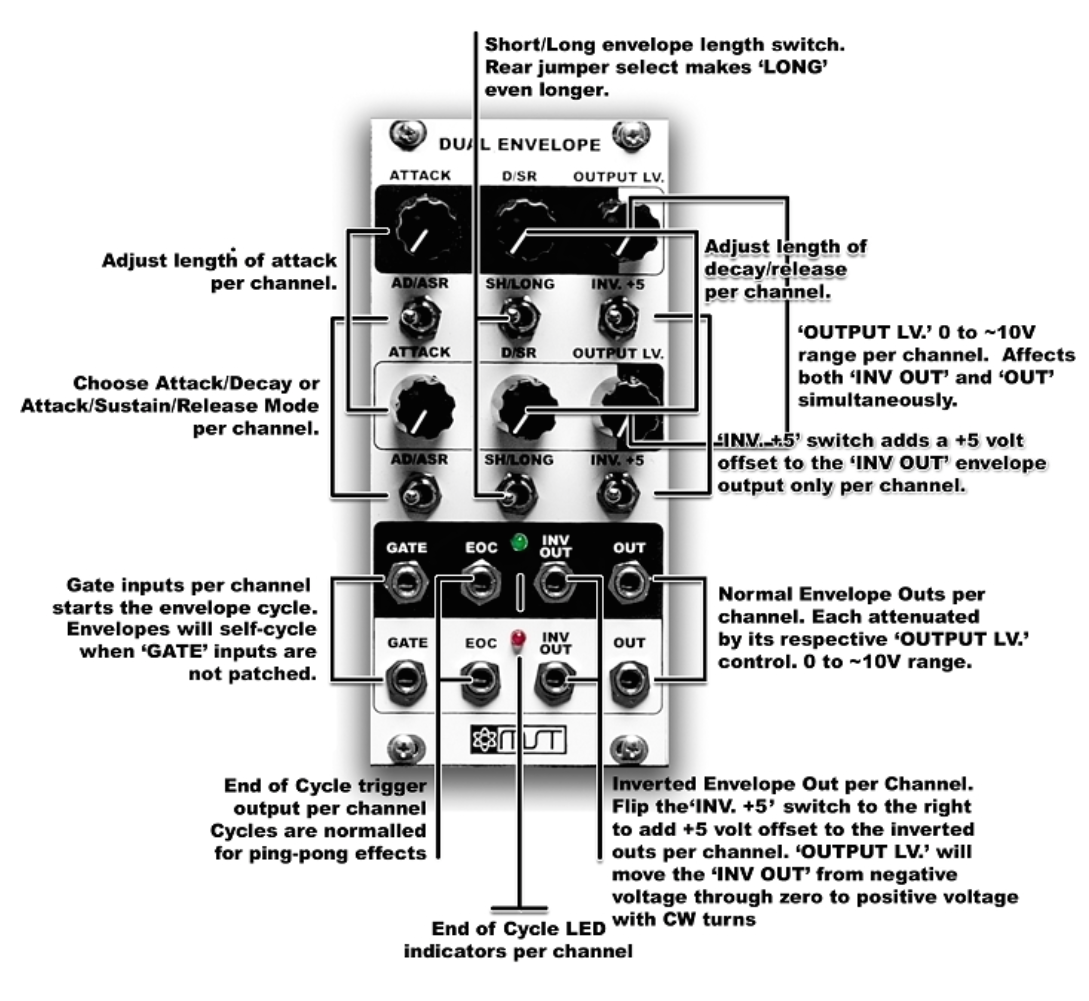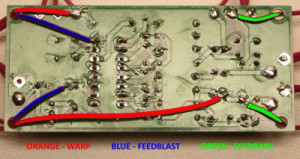Tag Archives: DIY
Hexinverter.net Mutant hot Glue DIY on DRUMS!
In this video I showcase the Hexinverter.net Mutant Hot Glue on the Dave Smith Instruments Tempest drum machine. I show the different flavors of distortion and compression. More to come so stay tuned!
4 Channel Mixer with Effects Send

Synthrotek MST Dual Envelope for Eurorack Modular Synth
The MST Dual Envelope is a simple-to-use yet complex dual envelope generator. Channels 1 and 2 are both normalled to each other to cycle when the other respective channel hits end of cycle, allowing for really interesting ping-pong effects. Each channel also has an end-of-cycle trigger output with LED indicator. There’s a normal and inverted envelope out. The inverted envelope out can be further modified by the +5 offset switch, which allows the inverted waveform to travel in the positive. The + output level allows the envelope signal to go between zero and the maximum voltage rail. Attenuate the output level down for a more subtle envelope (adjust to taste).
Features:
Two self-completing envelope circuits
AD or ASR selector switch per channel
Manual Attack control & Decay/Release
Output level per channel
Gate input
End-of-cycle trigger output with LED indicator
Normal & Inverted envelope output per channel
Short and long envelope length switch per channel
Long setting can be lengthened with jumper select
AD/ASR selection switch per channel
Inverted output +5 offset switch per channel
Specifications:
Current draw: V+ max 10mA, V- max 8mA
Width: 12HP
Retail price = $224.99
How To Synth DIY project part 6 Chaos NAND , Delay etc
Now that the Circuits have all been Built. we can wire them all together. This is really quite straight forward. Simply wire everything in parallel. This means that the power wiring for each module goes directly back to the source. This allows us to not have voltage drop across each component.
make sure to leave plenty of extra wire so that you can place knobs and connectors where ever you want in your enclosure.
I will return shortly to show how everything is mounted in the case and give it a nice run through!
How to Synth DIY part 5 PT2399 Delay Dev board!
Part 5 The PT2399 DEV DELAY KIT
This circuit is actually very very simple to assemble and shouldn’t really take you more than a half hour tops to build.
It comprises of a board with pads for a few knobs and jacks, as well as a few extra parts so that you can play around and add modifications to the circuit. The PT2399 is a chip that is found in MANY guitar delay pedals. It is a digital chip that emulates the analog bucket brigade. As delay times get longer, the audio degrades. This can be used to great effect when you start to play with long delay times and feedback.
In this video I build the PT2399 Dev board, I do not show me building in any mods. The reason for this is I want you to feel free to experiment with the board. you won’t harm the chip its quite robust and is great fun to play with “circuit bending” it. just basically wire up a momentary switch (included with the kit) and touch the leads to any two points you find interested (by poking a piece of wire around you may find the chip behavior act interesting). For the final circuit I went with the suggested Feedblast the warp and the feedback as pictured below.
instructions for these mods can be found HERE https://www.synthrotek.com/kit-assembly-instructions/other/pt2399-dev-delay-assembly-instructions/
The kit only costs : $30 so… hard to beat for a funky ass delay right?
Check the video and have fun!
How to Synth DIY part 3 The Passive Ring Modulator
The Passive Ring Modulator
This circuit is a very basic one which is why I have chosen it to be our starting point. It is also quite inexpensive with very easy soldering so it should make a great first time soldering project!
A ring Modulator basically takes two incoming signals and combines them spitting out what results in a modulated version of the original signal. This technique was used to create the famous Dalek voices in DR. Who television series.
It can also be used to beef up synth signals, Warp Drum tones, and distort strings etc. overall just a very useful circuit to have handy.
The Passive Ring Mod doesn’t require a power source so no worries there.
Take a look at the video and Have FUN!!!
Here is the Link for Synthrotek’s Passive Ring Mod https://www.synthrotek.com/kit-assembly-instructions/other/passive-ring-modulator-assembly-instructions/

HOW to Synth DIY Series Part 2 (Kit list and soldering info)
How to synth DIY part 2
Now that we have established some basics it is time to take a look at what we are actually going to be doing in this series. I want to start off by giving a list of the Synthrotek Kits we will need in order to complete this series. You can purchase these kits as we go along or all of them upfront (getting them upfront is not a bad idea as we will likely have some live Q&A sessions and it will be nice for you to have the kits ready).
Here are the planned kits that will be involved.
1) Passive Ring Mod Kit (think Dalek voice)
2) 4093 Chaoss Nand kit (drone oscillator)
3) 555 Timer kit (this will be used as an LFO to control delay etc)
4) Dirt Filter 9v kit (distortion and filtering)
5) PT2399 Dev Board kit (this is a digital delay that emulates analog delay chips)
6 Vac Pack (adds CV control to any variable resistance controlled circuit)
7) Plastic Enclosure (this will be what we place all our items into) you are not limited to use just this case, feel free to use more than one case or a larger case if you like.
Synth DIY Project series Part 1 (getting into Synth DIY)
How to Synth DIY
Here at FluxWithIt.com there is a mind set… If you are not thinking beyond intended operation, then you are limiting yourself. To better illustrate this philosophy as it pertains to the studio. I have decided to take you all with me on down the rabbit whole and into a land where an old guitar pedal is a synth, a simple 555 timer chip is a modulation source, a plain plastic box can become a sample manglers wet dream. Luckily with Sponsor Synthrotek I will be able to help you on your journey to Nerd heaven.
Before we take the blue pill and get to tripped out on bending and circuit melding, Lets gather our thoughts.
First we need to assess just what it is we SHOULD know before attempting any of this.
here are some bullet points of what I feel you should know… and I will help assist you in learning. Continue reading




